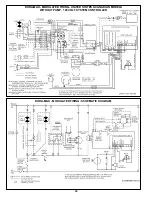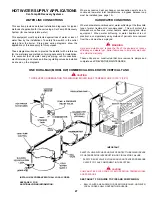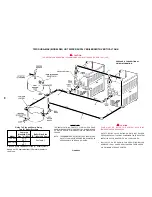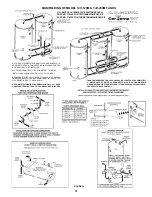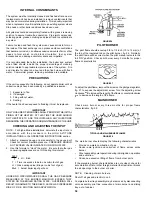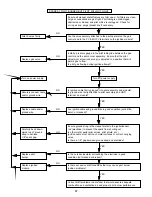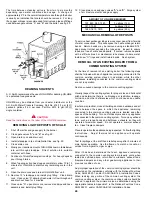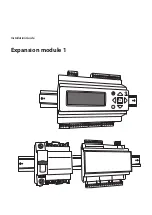
39
CAUTION
DO NOT USE A NYLON BRUSH OR OTHER STATIC CREATING
MATERIAL TO CLEAN DUST AND CARBON DEPOSITS FROM
HEATING SURFACES AND VENT.
SUCH DEPOSITS ARE FLAMMABLE AND MAY BE IGNITED BY
STATIC ELECTRICITY. USE A METAL BRUSH TO MINIMIZE THE
DANGER OF EXPLOSION
1.
Turn off the electrical power, main manual gas shutoff and
pilot valves.
•
Allow boiler parts to cool before disassembly.
2.
Remove the internal flue collector and vent pipe running to the
chimney.
•
Check parts and chimney for obstructions and clean as
necessary.
3.
Remove burners from boiler and other metal parts as required
to clean as necessary.
•
Refer to parts list supplied with this manual for disassembly
aid.
4.
Clean and reinstall the parts removed in steps 2 and 3.
•
Be sure the vent pipe has a minimum upward pitch of one
quarter inch per foot of length and is sealed as necessary.
5.
Restore electrical power and gas supply to boiler.
•
Check for gas leaks and proper boiler and vent operation.
HEAT EXCHANGER
PREVENTIVE MAINTENANCE
In most water supply systems some solids exist. As the water is
heated, these tend to drop out depositing as scale or lime. This
scale is relatively easy to remove before the unit becomes clogged.
WARNING
Lime accumulation can reduce the life of the equipment, reduce
efficiency and waste fuel. Boiler failure due to lime or scale build-
up voids the warranty.
See section on CIRCULATING PUMP to ensure you have selected
the proper size pump for your situation.
DELIMING
The amount of calcium carbonate (lime) released from water is in
direct proportion to water temperature and usage. The higher the
water temperature or water usage, the more lime deposits are
dropped out of the water. This is the lime scale which forms in
pipes, boilers and on cooking utensils.
The usage of water softening equipment greatly reduces the
hardness of water. However, this equipment does not always
remove all of the hardness (lime). For this reason it is recommended
that a regular schedule for deliming be maintained.
Figure 29 shows typical piping arrangement for gravity deliming of
lime deposits. For systems using recirculating deliming pumps
contact your A. O. Smith distributor.
Lime build-up may be seen when viewing the interior of the inlet/
outlet manifold through the pressure relief valve tapping.
GENERAL MAINTENANCE
These boilers are designed to give many years of efficient and
satisfactory service when properly operated and maintained. To
assure continued good performance, the following
recommendations are made.
The area around the unit should be kept clean and free from lint
and debris. Sweeping the floor around the boiler should be done
carefully. This will reduce the dust and dirt which may enter the
burner and pilot air passages, causing improper combustion and
sooting.
THE FLOW OF COMBUSTION AND VENTILATION AIR TO THE
BOILER MUST NOT BE OBSTRUCTED.
THE BOILER AREA MUST BE KEPT CLEAR AND FREE FROM
COMBUSTIBLE MATERIALS, GASOLINE AND OTHER
FLAMMABLE VAPORS AND LIQUIDS.
Any safety devices including low water cutoffs used in conjunction
with this boiler should receive periodic (every six months)
inspection to assure proper operation. A low water cutoff device
of the float type should be flushed every six months. All relief
valves should be inspected and manually operated at least twice
a year. More frequent inspections may be necessary depending
on water conditions.
Periodic checks, at least twice a year, should be made for water
and/or gas leaks.
More frequent inspections may be necessary depending on water
conditions.
The boiler mounted gas and electrical controls have been designed
to give both dependable service and long life. However,
malfunction can occur, as with any piece of equipment. It is
therefore recommended that all components be checked
periodically by a qualified serviceman for proper operation.
RELIEF VALVE
The safety relief valve should be opened at least twice a year to
check its working condition. This will aid in assuring proper
pressure relief protection. Lift the lever at the top of the valve
several times until the valve seats properly and operate freely.
DANGER
THE WATER PASSING OUT OF THE VALVE DURING CHECKING
OPERATION MAY BE EXTREMELY HOT. BEFORE OPERATING
RELIEF VALVE MAKE SURE DRAIN LINE IS INSTALLED TO
DIRECT DISCHARGE TO A SAFE LOCATION SUCH AS AN OPEN
DRAIN, TO AVOID SCALDING OR WATER DAMAGE.
WARNING
SHOULD OVERHEATING OCCUR OR THE GAS SUPPLY FAIL
TO SHUT OFF, TURN OFF THE MANUAL GAS CONTROL VALVE
TO THE APPLIANCE.
VENTING MAINTENANCE
Qualified servicers should follow this procedure when the boiler’s
external heating surfaces and vent pipe need cleaning.


